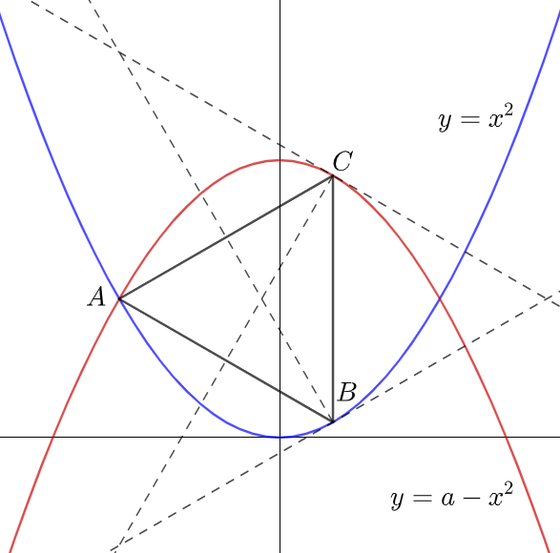Parabolic Billiard

In the rectangular plane, the particle deflects two parabolas - the blue curve represented by and the red curve represented by for some real constant . It starts at the intersection point , passes through two symmetric reflection points and (about the horizontal) and travels back at , which forms an equilateral triangle. As shown, those dashed lines as angle bisectors indicate the particle reflects at the same angle to the normal. It can be shown that the side length of the triangle is , where and are both coprime positive integers. Find the value of .
Assumption: Treat the particle as a point.
The answer is 7.
This section requires Javascript.
You are seeing this because something didn't load right. We suggest you, (a) try
refreshing the page, (b) enabling javascript if it is disabled on your browser and,
finally, (c)
loading the
non-javascript version of this page
. We're sorry about the hassle.
Let the coordinates of A be ( a , a 2 ) and B be ( b , b 2 ) , and let s = A B = B C = A C .
By symmetry, the tangent line at B must have a slope of m = tan − 1 3 0 ° = 3 3 , and by its derivative, m = d x d y = 2 x = 2 b at B , so m = 3 3 = 2 b , or b = 6 3 .
From the equilateral triangle, A x = a = b − 2 3 s = 6 3 − 2 3 s = 6 3 ( 1 − 3 s ) and A y = a 2 = b 2 + 2 1 s = 1 2 1 + 2 1 s = 1 2 1 ( 1 + 6 s ) .
That means a 2 = ( 6 3 ( 1 − 3 s ) ) 2 = 1 2 1 ( 1 + 6 s ) , which solves to s = 3 4 . Therefore, b = 4 , c = 3 , and b + c = 7 .